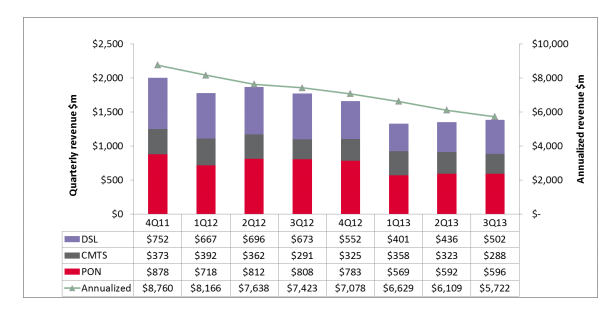Huawei is leading the wireline broadband access equipment revenues market with 28 percent share in the third quarter of 2013, Ovum said.
The market share of Alcatel-Lucent in the wireline broadband access equipment revenues space is 18 percent in Q3.
Chinese telecom equipment maker ZTE is in the third position with 13 percent share.
Ovum in a statement said the global wireline broadband access equipment revenues dipped 22 percent compared to Q3 2012.
PON OLT ports and VDSL port shipments grew. Cisco posted a 17 percent sequential quarterly gain within declining CMTS revenues.
Worldwide quarterly access equipment revenues remain below the early 2011 peak when China’s large PON deployments began and before significant ASP declines in PON equipment.
PON shipments continue in China, Japan, Korea, other countries in Asia, EMEA, and South & Central America but there are no massive large-scale deployments. The new Broadband China initiative could boost future PON shipments.
10G EPON deployments are at an early stage in Asia-Pacific and North America. In October, Alcatel-Lucent announced a win with US cable operator Bright House Networks.
VDSL/VDSL2 shipments remain strong, boosting total DSL revenues. VDSL/VDSL2 shipments are likely to remain strong as vectoring deployment plans will increase copper’s bandwidth capabilities.
While CMTS revenues were down sequentially, Cisco posted significant sequential and year-over-year shipment growth.
“While FTTx, VDSL and CMTS shipments will continue, there are no new large deployments in heavily populated countries that will raise revenues to the levels seen during China’s initial FTTH ramp,” said Julie Kunstler, principal analyst, Network Infrastructure at Ovum.
Ovum report says the use of PON for non-FTTH is growing within mobile backhaul and optical LAN (enterprise) applications. Interest in boosting copper speeds through VDSL2 vectoring is strong. Fiber deployments are pushing closer to subscribers, but the final connection is dependent upon monetization and regulation.






